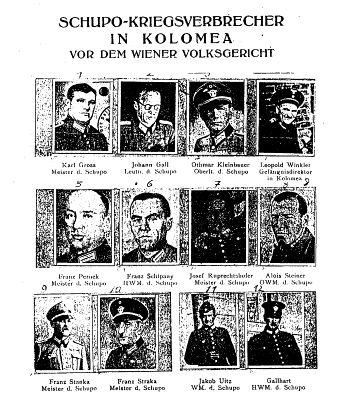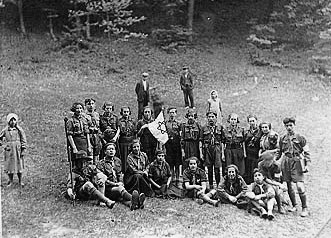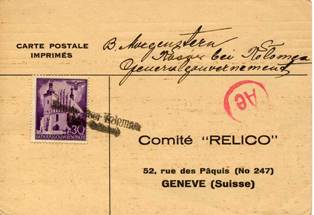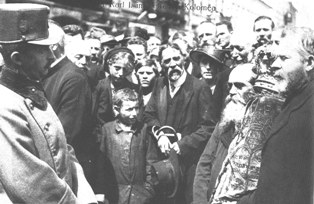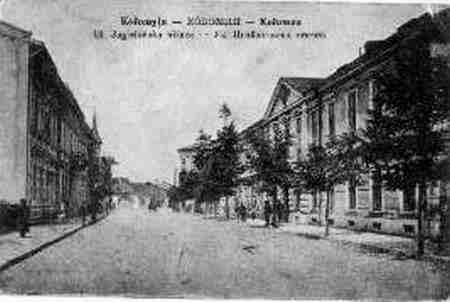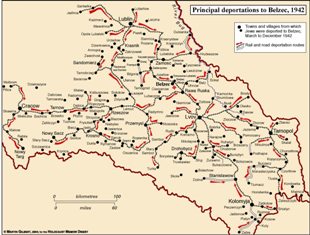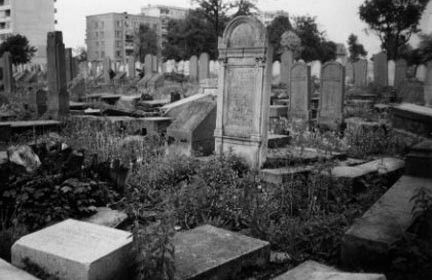Holocaust Education & Archive Research Team |
|
Belzec
Belzec Images Transports Belzec Articles ---------------------------
A-R Leadership
A-R Articles
Action Erntefest Modern Research | ||||
Deportations from Kolomea to Belzec Death Camp
Police Reports
7. Pol. 24 Tgb. Nr 64/42 (g). Lemberg 14 September 1942
To:
Commander of the Order Police in the Galicia District
Lemberg
Subject: Jewish Resettlement
After carrying out Jewish resettlement actions on 3 and 5 September 1942 in Skole, Stryj and Chodorow, for which Captain of the Schutzpolizei Kropelin was in charge of the Order Police involved and which has already been reported in detail, the 7th Company of the 24th Police Regiment arrived as ordered in Kolomea on the evening of 6 September.
I immediately contacted Kriminalkommissar and SS- Obersturmfuhrer Leitmeritz, head of the branch office of the Security Police in Kolomea, and First Lieutenant Hertel of the Schutzpolizei in Kolomea
Contrary to the experience in Stryj, the action planned for 7 September 1942 in Kolomea was well prepared and made easy for all units involved. The Jews had been informed by the above mentioned agencies and the Labour office to gather at the collection point of the Labour office for registration on 7 September at 5.30 a.m.
Some 5,300 Jews were actually assembled there at the appointed time. With all the manpower of my company, I sealed the Jewish quarter and searched thoroughly, whereby some 600 additional Jews were hunted down.
The loading of the transport train was completed about 7.00 p.m. After the Security Police released some 1,000 from the total rounded up, 4,769 Jews were resettled. Each car of the transport was loaded with 100 Jews. The great heat prevailing that day made the entire action very difficult and greatly impeded the transport. After the regular nailing up and sealing of all cars, the transport train got underway to Belzec about 9.00 p.m. with a guard of one officer and nine men.
With the coming of deep darkness in the night, many Jews escaped by squeezing through air holes after removing the barbed wire. While the guard was able to shoot many of them immediately, most of the escaping Jews were eliminated that night or the next day by the railroad guard or other police units. This transport was delivered in Belzec without noteworthy incident, although given the length of the train and the deep darkness, the guard had proved to be too weak, as the commander of the transport guard from 6th Company of Police Regiment 24, who returned directly to Stanislau, was able to report to me in person on 11 September.
On 7 September, some 300 Jews – old and weak, ill, frail, and no longer transportable were executed. According to the order of 4 September 1942 of which I was first informed on 6 September, concerning use of ammunition, 90% of those executed were shot with carbines and rifles. Only in exceptional cases were pistols used. On 8 and 10 September 1942, actions in Kuty, Kosow, Horodenka, Zaplatow and Snityn (?) were carried out. Some 1,500 Jews had to be driven on foot marches 50 km from Kuty or 35 km from Kosow to Kolomea, where they were kept overnight in the courtyard of the Security Police prison with other Jews brought together from the region.
Other than the Jews rounded up in Horodenka and Sniatyn, who had already been loaded onto ten cars at each location by the Security Police, another 30 cars were loaded in Kolomea. The total number sent to Belzec on the resettlement train of 10 September 1942 amounted to 8,205 In the actions in the area around Kolomea on the 8, 9 and 10 September 1942, some 400 Jews had to be eliminated by shooting for the well- known reasons. In the great round up of Jews to be resettled by 10 September in Kolomea, the Security Police loaded all Jews into the 30 available train cars despite the objections I expressed. Given the great heat prevailing on those days and the strain on the Jews from the long foot marches or from waiting for days without being given any provisions worth noting, the excessively great overloading of most of the cars with 180 to 200 Jews was catastrophic in a way that had tremendously adverse effects on the transport. How densely the ten cars each in Horodenka and Sniatyn were loaded with Jews by the Security Police is beyond my knowledge. In any case, both transports arrived in Kolomea with completely inadequate guard, so that the barbed wire closing the air holes was almost entirely removed
As quickly as possible I had this train moved out of the train station in Kolomea and coupled with the 30 cars standing on a side track far from the station. The Jewish Police and members of the train station construction crew from Kolomea were employed until the onset of darkness to close up all the insufficiently sealed cars in the usual regulation manner.
A commando of one officer and fifteen men under the leadership of Captain Witzmann was assigned to guard the parked resettlement train of 50 cars until departure and to prevent any escape attempt.
Given the already described strains on the Jews, the negative effect of the heat, and the great overloading of most cars, the Jews attempted time and again to break out of the parked train cars, as darkness had already set in towards 7.30 p.m.
At 7.50 p.m. the guard commando of the resettlement train, with nine men under Corporal Jacklein, arrived at the side track. Breakout attempts from the parked train could not be prevented in the darkness, nor could escaping Jews be shot in flight. In all train cars Jews had completely undressed because of the heat.
As the train left Kolomea on schedule at 8.50 p.m. the guard took up their stations. The guard commando, as initially stipulated by me, was divided into five men in a passenger car at the front and five men in a passenger car at the end of the train.
On account of the length of the train and its total load of 8,205 Jews, this distribution proved to be unsuitable. Next time Corporal Jacklein will arrange a distribution of guards along the entire train. Throughout the entire trip the policemen had to remain in the cabooses, in order to be able to counter the escape attempts of the Jews. Shortly into the journey the Jews attempted to break through the sides and even through the ceilings of certain train cars. They were partially successful in perpetrating this scheme, so that already five stations before Stanislau.
Corporal Jacklein had to ask the stationmaster in Stanislau by telephone to lay out nails and boards in order to seal the damaged cars as required by orders and to request the station guard to watch the train. As the train entered Stanislau, the train station workers and the station guards were present to carry out the necessary repairs and in addition take over guarding the train. The work took one and a half hours. When the train subsequently resumed its journey, it was discovered at the next stop some stations later that once again large holes had been broken by the Jews in some of the train cars and that for the most part the barbed wire fastened on the outside of the ventilation windows had been torn off.
In one train car the Jews had even been working with hammer and saw. Upon interrogation they explained that the Security Police had left these tools with them, because they could make good use of them at their next work place. Corporal Jacklein made the Jews hand over the tools.
During the onward journey, at every station stop, help was needed to nail up the train, because otherwise the rest of the trip would not have been at all possible. At 11.15 a.m. the train reached Lemberg (Lvov).
SS- Obersturmfuhrer Schulze then had some additional 1,000 Jews loaded. About 1.30 p.m. the transport departed for Belzec. With the change of engine in Lemberg, such an old engine was hooked up that further travel was possible only with continuous interruptions.
The slow journey was time and again used by the strongest Jews to press themselves through the holes they had forced open and to seek their safety in flight, because in jumping from the slow-moving train they were scarcely injured. Despite the repeated requests to the engineer to go faster, this was not possible, so that the frequent stops on open stretches became increasingly unpleasant. The ever greater panic spreading among the Jews due to the great heat, overloading of the train cars, and smell of dead bodies – when unloading the train cars some 2000 Jews were found dead in the train – made the transport almost unworkable.
At 6.45 p.m. the transport arrived in Belzec and around 7.30 p.m. was turned over by Corporal Jacklein to the SS- Obersturmfuhrer and head of the camp there. Until the unloading of the transport around 10.00 p.m. Jacklein had to remain in the camp, while the escort commando was used to guard the train cars parked outside the camp.
Because of the special circumstances described, the number of Jews who escaped from this transport cannot be specified. Nonetheless, it can be assumed that at least two-thirds of the escaping Jews were shot or rendered harmless in some other way.
Reserve Lieutentant of the Schutzpolizei And Company Commander
Schutzpolizei Zugwachtmeister Jacklein’s Report
Zugw. d. SchP. Josef Jacklein 7/ Pol. 24 in Lemberg
Lemberg 14 September 1942
Report
Subject: Resettlement from Kolomea to Belzec
On 9 September 1942 I received orders to take over command of the Jewish resettlement train which was leaving Kolomea for Belzec on 10 September 1942.
On 10 September 1942 at 19.30 hours in accordance with my orders, I took over command of the train together with an escort unit consisting of one officer and nine men at the railway yard in Kolomea.
The resettlement train was handed over to me by Hptw d Schp Zitzmann. When it was handed over to me the train was already in a highly unsatisfactory state. Hptw Zitzmann had informed me of this fact when he handed it over to me.
As the train had to depart to schedule and there was no other person who could take responsibility for loading on the Jews, there was nothing left for me to do but take charge of the transport train in its unsatisfactory state.
The condition of the train notwithstanding, the insufficient number of guards – i.e. one officer to nine men in the escort unit – would have been reason enough for me to refuse to take over command of the train. However, in accordance with my orders, I had to take over the train with the escort manpower I had. Hauptwachtmeister Zitzmann stayed at the station with his guard unit until the train departed.
Both units had their hands full preventing Jews escaping from the cars, since it had meanwhile become so dark that it was not possible to see the next car properly. It was not possible to establish how many Jews escaped from the train before its departure alone, however it is probable that almost all were eliminated during their escape attempts.
At 20.50 the train departed from Kolomea on schedule. Shortly before its departure I divided up my escort squad, as had been planned beforehand, putting five men at the front and five men at the rear of the train.
As the train was, however, very long – fifty-one cars with a total load of 8,200 Jews – this distribution of manpower turned out to be wrong and the next time we stopped I ordered the guards to post themselves right along the length of the train. The guards had to stay on the brake housing for the entire journey.
We had only been travelling a short time when the Jews attempted to break out of the wagons on both sides and even through the roof. Some of them succeeded in doing so, with the result that five stations before Stanislau I phoned the stationmaster in Stanislau and asked him to have nails and boards ready so that we could board up the damaged cars temporarily and to put some of his Bahnschutz at my disposal to guard the train.
When the train reached Stanislau the workers from Stanislau station as well as the Bahnschutz were at the station waiting for our train. As soon as the train stopped work began. An hour and a half later I considered it adequately repaired and ordered its departure.
However, all of this was of very little help, for only a few stations later when the train was stationary I established that a number of very large holes had been made and all the barbed wire on the ventilation windows had been ripped out.
As the train was departing I even established that in one of the cars someone was using a hammer and pliers. When these Jews were questioned as to why they had these tools in their possession they informed me that they had been told that they might well be of use at their next place of work. I immediately took away the tools.
I then had to have the train boarded up at each station at which it stopped otherwise it would not have been possible to continue the journey at all. At 11.15 hours the train arrived in Lemberg. As there was no replacement escort squad, my squad had to continue guarding the train until Belzec.
After a short stop at Lemberg station the train went to the suburban station of Kleparow where I handed over nine wagons to SS- Obersturmfuhrer Schulze which had been marked with an “L” and had been designated for Lemberg compulsory labour camp.
SS- Obersturmfuhrer Schulze then loaded on about 1,000 more Jews and at about 13.30 hours the transport departed again. At Lemberg the engine was replaced and an old engine was attached which was not powerful enough for the weight of the train. The train driver never managed to reach top speed with his engine so that the train, particularly when travelling uphill, moved so slowly that the Jews could jump off without any risk of injury.
I ordered the train driver on numerous to drive faster but this was impossible. It was particularly unfortunate that the train frequently stopped in open country. The escort squad had meanwhile used up all the ammunition that had been brought with us as well as an extra 200 bullets that I had obtained from some soldiers, with the result that we had to rely on stones when the train was moving and fixed bayonets when the train was stationary.
The ever- increasing panic among the Jews, caused by the intense heat, the overcrowding in the wagons….. the stink of the dead bodies – when the wagons were unloaded there were about 2,000 dead in the train – made the transport almost impossible.
At 18.45 the transport arrived in Belzec and I handed it over to the SS- Obersturmfuhrer and head of the camp at 19.30 hours. Towards 22.00 hours the transport was unloaded.
I had to be present during the unloading. I was not able to establish the number of Jews that had escaped.
(signed) Jacklein Zugwachtm d Schutzpol.
Sources:
Those were the days by Ernst Klee, Willi Dressen and Volker Riess, published by Hamish Hamilton London 1991. Sonderzug Nach Auschwitz by Raul Hilberg published by Dumjahn Mainz Germany 1981. Sir Martin Gilbert
Copyright CW with input from Robin O'Neill 2007 H.E.A.R.T
|

